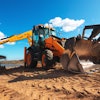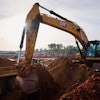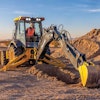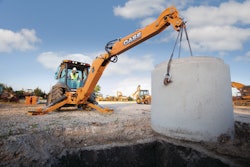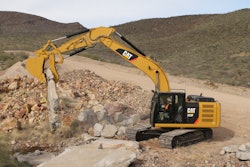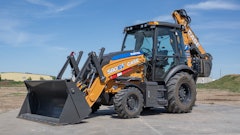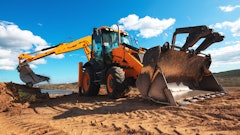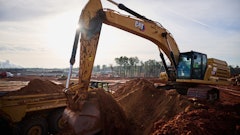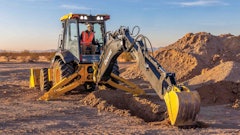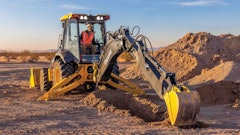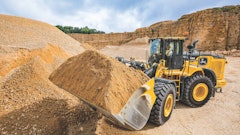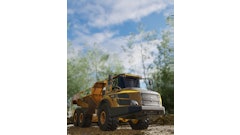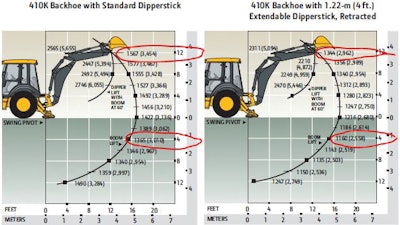
Safe lifting with a backhoe, or any machine, starts with knowing the weight of your load and the capacity of the machine. But if all you have is a backhoe’s maximum rated lift capacity, you really only know enough to be dangerous.
Backhoe lift capacity is most commonly rated based on their boom capacity at 12 ft. above grade, where most of them are at or near the maximum capacity.
At most other places in their working range, a backhoe’s lift capacity is less than its rated max. Many are at their lowest lift capacity around 4 ft. below grade, and the difference between the backhoe’s capacity at 12 ft. above grade and 4 ft. below grade can be as much as 15%; more than 400 lbs. for a common 14-ft. backhoe.
“You can lift a septic tank off the truck with no trouble at all,” says Katie Pullen, brand marketing manager for Case backhoe loaders, noting that the boom will be raised high to unload the truck. “But if you try to pick the old box out of the hole using the same chains [requiring the backhoe to work from the less-powerful lower part of its lifting range] you stall it out.”
Pullen recommends keeping a couple of lengths of good rigging with your machine. When you’re lifting near the backhoe’s capacity out of or into deep excavations, longer rigging keeps the boom up in its most powerful working range.
Another way to get more lifting power when you bump up against a backhoe boom’s lift capacity is to lift with the dipper-stick cylinder. With a shorter swing radius, the stick has mechanical advantage. Differences in capacity are huge. For example, a Case 580 Super N WT’s least dipper lift capacity, at 8 ft. above grade with a standard stick, is 5,562 lbs. – 37% more than its max boom-lift capacity.
Specifications: Case 580 Super N WT Backhoe Specifications, Lfit Chart
CAUTION: lifting with the dipper will reduce your working radius – as you lower the load into place, it will move toward you. You may have to move the machine closer to the trench in order to land the load in the same place you could reach if you were doing the work with the boom. Take extra care to be sure loading the machine closer to the edge of the trench doesn’t collapse the trench wall.
Another option for improving lift capacity: drop the bucket and rig to the eye on the coupler. The backhoe no longer has to lift the weight of the bucket.
But here’s the most important lesson: because each manufacturer designs their backhoe geometry a little differently, the load charts for different backhoes vary in different ways. You might have a very practical working knowledge of how much less a Deere backhoe will lift with the boom down in a hole than it will with it raised high, but the performance change on a Case or a Caterpillar backhoe is likely to be quite different.
For example, a Case 580 Super N WT will lift 3,413 lb. with the boom 12 ft. in the air, but only 3,175 lb. with the boom 4 ft. below grade. It’s a 7.5%, 238-lb. difference. A Deere 410K will lift 3,454 lb. with the boom at 12 ft., but only 3,010 with it 4 ft. down in the hole – that’s a 444-lb., nearly 15% difference.
Specifications: John Deere 410K Backhoe Loader Lift Chart
One machine isn’t better than the other – it all depends on where in the backhoe’s lift arc you do most of your heavy lifting.
The point is that there’s a much bigger difference between max lift capacity and minimum lift capacity from one machine to another. So in order to lift safely, you’d better be intimately familiar with the specific lift charts of any backhoes you’re using to pick heavy loads.

